
Please send all Checks and Money orders to :
Dave Taylor P.O. Box 87 Sylvania, OH 43560
419-842-1863
Click Here to E-mail Us!


19-06-01

17-07-157…
INSCRIBED COLT 1861 NAVY BELONGING TO CAPT. C.C. BAKER
These streamlined versions improving the design of the iconic 1851 Colt Navy were manufactured from 1861 through 1873 or so. They are almost identical to the 1860 Army, but a little smaller. This is a very nice example with very good grips showing lots of original varnish and just one old abrasion spot on the lower third of the left side. The fit of the wood to the metal is tight and there are traces of the silvering yet remaining on the brass and some of the screw heads still show blue and have sharp slots. Serial number 11260 matches throughout, giving it an 1863 date of manufacture. The wedge is not numbered. A small numeral 2 below (or above) the serial number indicates this pistol was one of a pair. The metal is generally silver gray with darker gray and a little underlying brown forward of the cylinder and minor spotting along the barrel to the muzzle, but not pitting. The cylinder, barrel, and frame stamps are crisp and legible. Even the Texas Navy cylinder scene, which is usually light on these, is visible. Bore and mechanics are good.
The butt strap is nicely engraved
“Capt. C.C. Baker” I found this gun in Colorado in 2018 fresh to the market. We have done extensive research and believe we have determined the owner. We researched all 485 soldiers named C. Baker. We eliminated those that did not attain the rank of Captain, or were out of the service before the gun were produced. And after all the sifting and sorting we were then left with only three candidates. There was a Maine Coast Guard captain. An infantry captain from New York. And then we have the most likely owner. Calvin C. Baker US V.O. and Q.M.
Our detective skills are as follow…. The fact that the pistol was one of a pair likely indicates the owner was an important staff officer who rode a horse. Like field officers, they served mounted and pairs of pommel holsters were common pieces of officers’ equipage. It is very unlikely that a captain serving on foot would acquire, or even want a pair of revolvers. The same is true of our lonely Maine Coast Guard captain. We are left then with only one good candidate: Capt. Calvin C. Baker (1808-1897: his middle initial of “C” is proved by the 1890 Veterans’ Census,) brother to Lafayette Baker, who was well known for his work in the Secret Service, was Provost Martial of Washington, D.C., running the “National Detective Bureau,” and later commanded the First D.C. Cavalry, as well as being a leading figure in the arrest of the Lincoln conspirators and tracking down John Wilkes Booth himself.
A series of newspaper columns by F. A. Stare titled “The History of Columbus” (Wisconsin) devoted several installments to Calvin C. Baker and asserts that he was involved in detective work with Lafayette before gaining appointment as Assistant Quartermaster in the US army in 1863 and suggests that Lafayette used his influence with Lincoln to gain the appointment for Calvin and that he may have been appointed, “for duties in which he had been trained.”
Lafayette Baker was involved in not only breaking up some shady operations, but in setting up a few as well, often not bothering with niceties of warrants or the observation of constitutional rights. Calvin apparently colored over the lines as well. Stare mentions some elegant pieces of furniture acquired from the Baker household after his death and his wife’s (a year later, in 1898.) “We have heard from two or three sources that while Capt. Baker was in the Quartermasters dept. in Washington, he was in a privileged position to acquire a number of very fine pieces of furniture taken from southern mansions during the Civil War, and that one fine divan or sofa was acquired by the late Charles Wesley Johnson, father of Walter, Harry, Paul and Miss Jessie Johnson….”
It is quite possible that Baker acquired some of his horse furniture in the same way he picked up his house furniture. In any case, we think our detective work has found the right man, and this is a nice pistol regardless. Calvin C. Baker was appointed AQM 4 July 1863 and honorably mustered out 31 July 1865.
$2,950.00
sold
Call us @ 419-842-1863

17-07-107…MINTY US CIVIL WAR INFANTRY WAISTBELT AND PLATE…
Superb Regulation US infantryman’s buff leather waistbelt. Buff leather was tough and resilient. The government found it hard to get enough of it when the war broke out and bridle leather belts were brought into service, as well as “waxed leather,” which simply used the rough side out in imitation of buff. Manufacturers eventually caught up with demand and a number of very mint examples remained in government stores at the end of the war. This is a great example. Originally black in color, the exterior of the belt has oxidized to brown from the use of iron in the dye. (Modern experiments indicate this likely happened within a few weeks once issued.) The interior still preserves its original cream color. The leather is a bit stiff, from storage, but still flexible and would look great with the proper accoutrements mounted on it. The original arrow-back oval US belt plate is still on it, showing a few age stains, but retaining a lot of the original gilt, as does the open C-clasp belt tip. Most other dealers price these at $500 to $650. I can sell this one for
$450.00
sold
Call us @ 419-842-1863
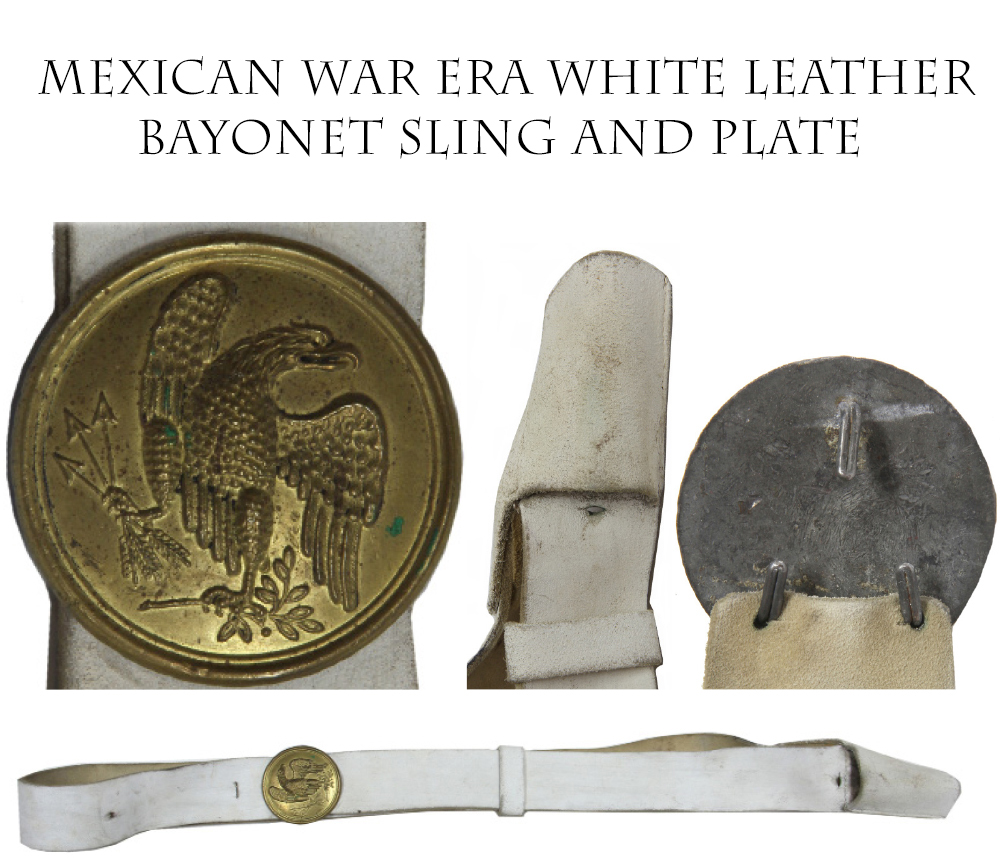
17-07-109 … WHITE BUFF BAYONET SHOULDER BELT WITH ROUND EAGLE BELT PLATE …
1830s-1840s US white buff bayonet belt and plate. US infantry, and artillery serving as infantry, carried their bayonets on shoulder belts until 1842. In 1826 these round eagle belt plates were introduced as an adjusting buckle, for those belts. Infantry were initially issued white metal versions, but in 1831 gilt brass was adopted for both branches of service. The belt itself is full length and flexible. The interior shows a light cream color. The exterior was certainly whitened a number of times over the years, but now has a nice somewhat muted tone. The single pocket frog is slotted on the interior for the 1839 pattern bayonet scabbard. The plate shows nice level fill on the reverse and three doubled-wire hooks. The face has a good 40 or 50 percent of its original gilt in the lower areas. On the raised portions it was obviously rubbed, but these now have a pleasing aged patina. After the bayonet was moved to the waist belt in 1842, this pattern of shoulder belt and plate was retained for sergeants and musicians. The position of the slot in the frog, however, indicates it is a true 1826 pattern bayonet belt.
$495.00
sold
Call us @ 419-842-1863
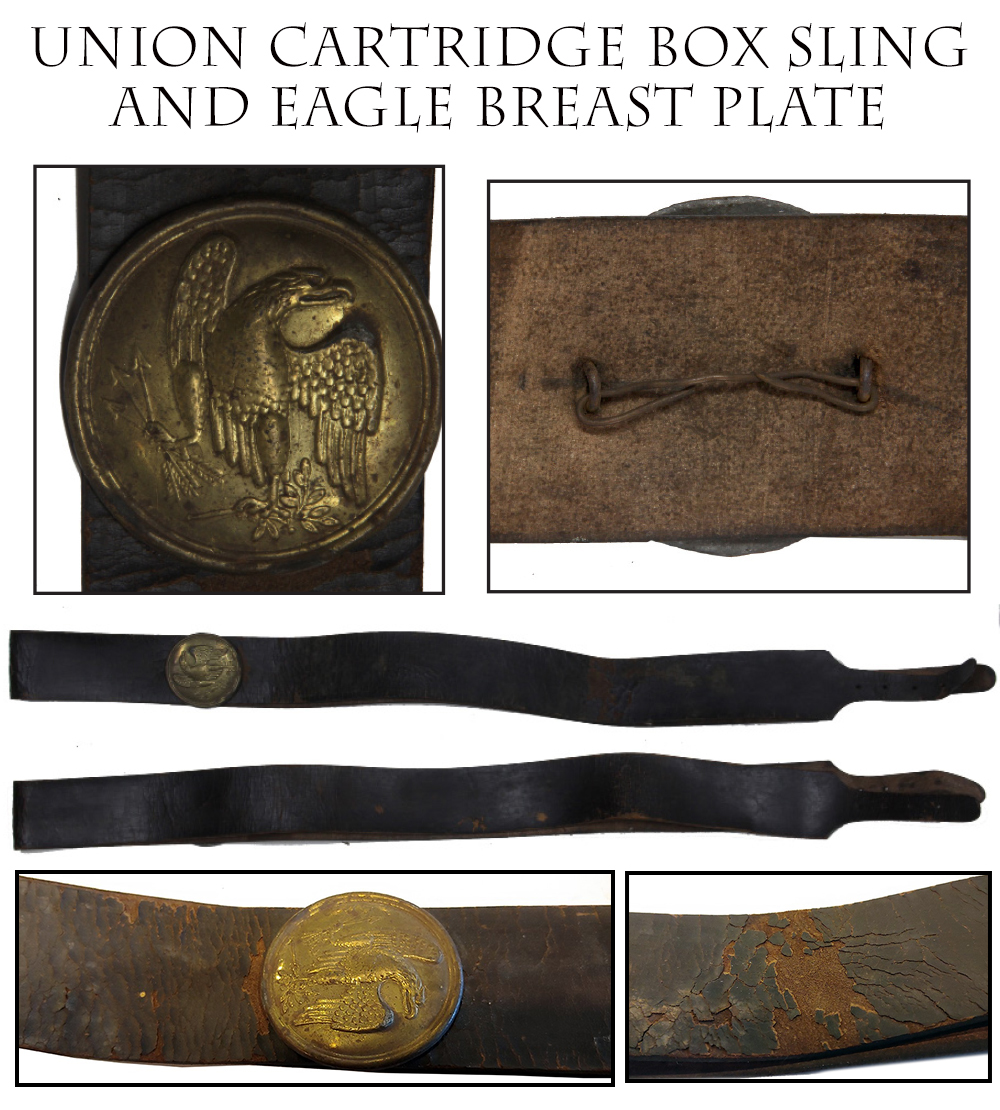
17-07-110… UNION CARTRIDGE BOX SLING AND EAGLE BREAST PLATE
… An original Civil War cartridge box sling. Black bridle leather, unbroken, with both billets in place to engage the buckles on the bottom of the infantry cartridge box. Crazing and crackling to the finish overall. One spot close to one end has a very bad spot where the black finish is rising up and ready to flake off. An original eagle shoulder belt plate (breastplate) is still affixed and has been on there forever, fastened with a twisted piece of wire through the fastening loops. The plate has age spotting and some wear to the high points, all to be expected on an original piece that was actually issued and worn. Needless to say, these are tough to find on the loose and this would complete a cartridge box very nicely.
$295.00
sold
Call us @ 419-842-1863

17-07-111
INDIAN WAR CANTEEN:
The US 1878 pattern canteen was arsenal altered utilizing a Civil War canteen and removing the bottom strap bracket and fastening two swiveling triangular loops to the upper brackets. The canteen was slung from a detachable leather sling that adjusted for length with hooks and had a double-wire brass hook at each end to engage the triangles. The stopper was also altered by using a short length of brass safety chain that engaged a rotating brass wire loop around the neck of the spout. This one is in good condition and retains its original canvas cover that shows scattered dirt and stains, but still has the regulation U.S. stencil on the cover.
$85.00
sold
Call us @ 419-842-1863

17-07-112
SHAVING SET FOR USE IN THE FIELD
An unusual tinned iron shaving mug. This one still has its removable soap dish with it and is in solid shape. The presence of a wire bail handle is unusual and interesting. We see commercial mess cups set up like this to enable a soldier to hang a cup over a fire and use it as a boiler. This is one of the few shaving mugs I have seen set up like that and it is plainly meant for use in the field, where a soldier might have to do his shaving with the mug suspended from a tree branch. Also included is a good period razor strop in its pasteboard sleeve and a period horn-handled folding straight razor made and marked by Halsted of Sheffield. A nice addition to a display of the typical soldier’s personal gear. None of this gear was issued by the army, of course. Both officers and men had to supply themselves from the folks back home, purchases in a nearby town, or from the ever-loved army sutler.
$195.00
sold
Call us @ 419-842-1863
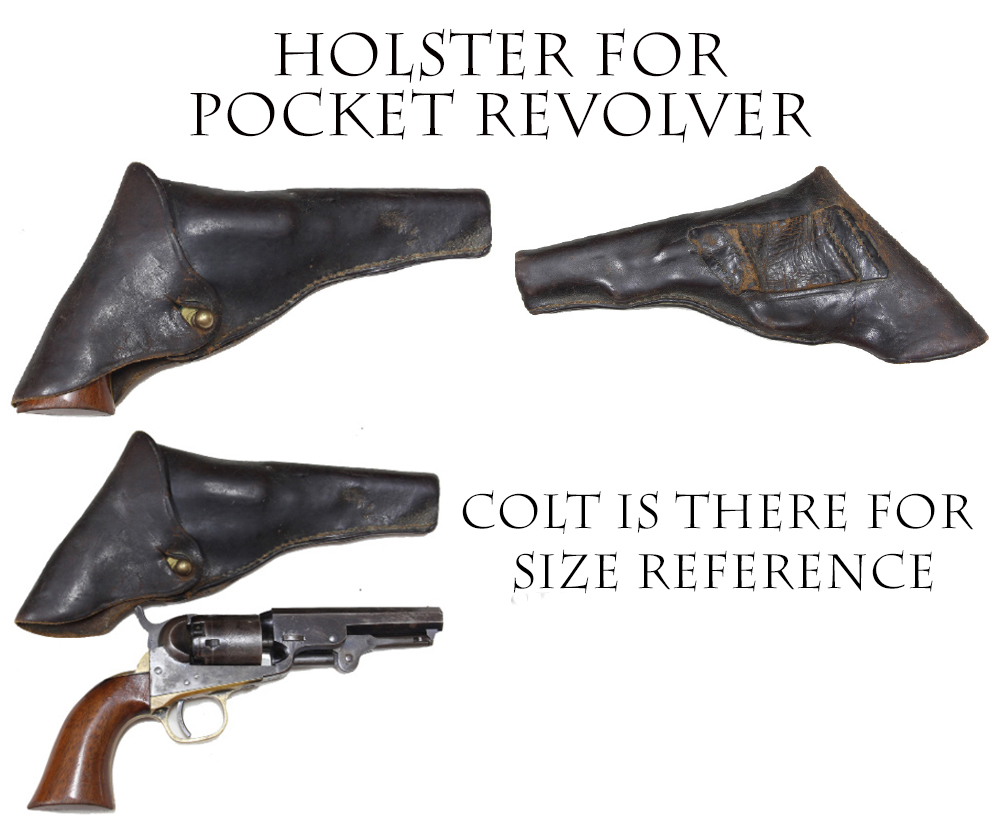
17-07-114… HOLSTER FOR POCKET REVOLVER
…Civil War officers supplied their own sidearms and infantry officers, while anxious to have a revolver for self-defense, were not prone to haul around heavy army caliber revolvers. The Colt 1849 pocket revolver was a favorite for all the obvious reasons. This is very good example of the typical commercially available holster for one with a 4 inch barrel. Black narness leather oxidized nicely to brown. One piece, full flap with hole for the brass fastening stud and a simple tooled border line extending around the border of the flap. The belt loop is in place, solid, and of medium width. Made without a end plug. The holster is set up to be carried butt-to-the-rear. This would plainly go well with a Colt pocket, but is especially appropriate for a grouping of an officer’s field gear. A very handsome CW officer’s holster.
$195.00
sold
Call us @ 419-842-1863
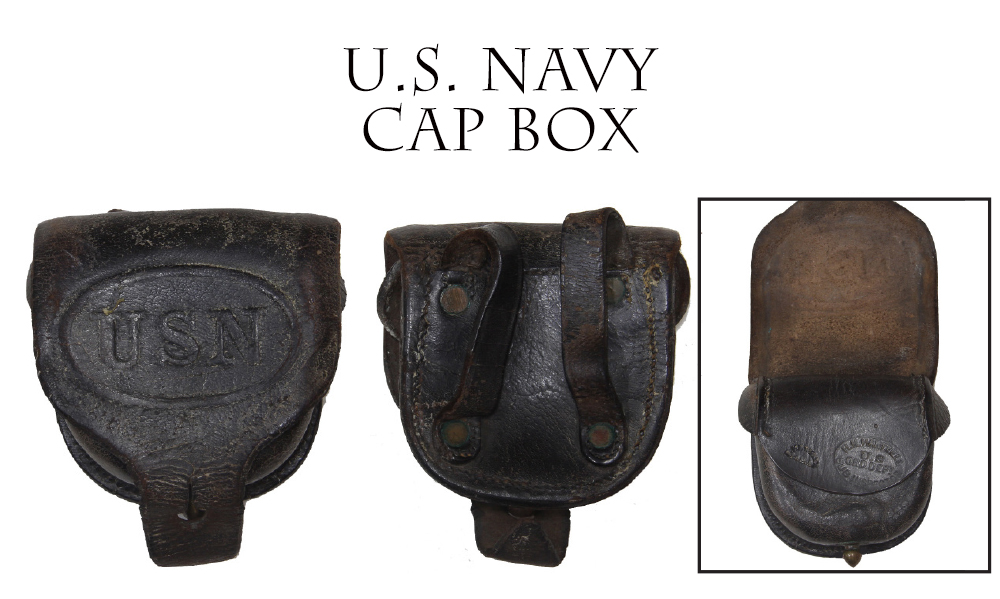
17-07-116… U.S. NAVY MARKED CAP BOX
…. This is a scarce Civil War cap box made by Metzger and inspected by Hartzell. Both cartouches are still sharp on the inner flap. The side ears of the inner flap and the belt loops on the reverse are in place and solid. The exterior of the flap shows crackling and crazing to the finish overall, but the embossed USN in an oval on the face still stands out well. Shows some age. Solid. Great display item.
$275.00
sold
Call us @ 419-842-1863
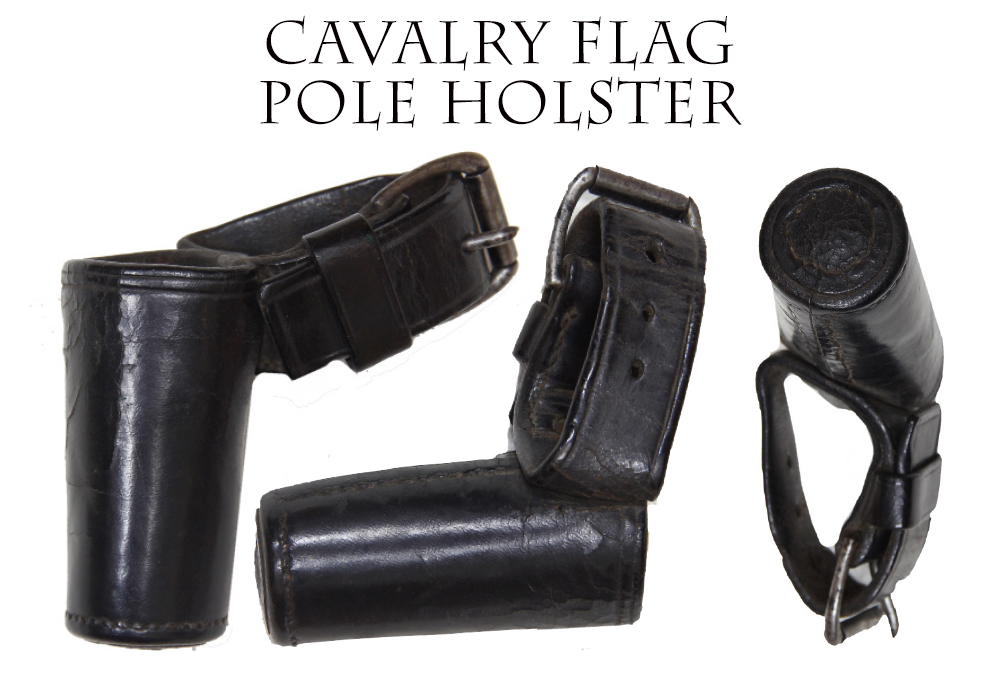
17-07-117… CAVALRY OR ARTILLERY GUIDON SOCKET
Cavalry companies and light artillery batteries had guidons to identify the location of commanding officers and aid the troops in maneuvering. Here is a very, very scarce example of a guidon socket with its fastening strap, enabling it to be buckled to the right stirrup, or around the stirrup strap, of the soldier carrying the flag. The butt of the staff would be inserted in the socket and our trooper was good to go. Made of thick black leather similar to the carbine sockets, the tube is solid and the fastening strap is intact and supple. The roller buckle shows some traces of its original black japanning, but is mostly gray metal. These could also be used for mounted regimental standards, of course. I don’t thnink you will find another for sale at this time. A truly scarce piece of gear.
$475.00
SOLD
Call us @ 419-842-1863

17-07-118…MANN’S PATENT CAVALRY SABER BELT
A very scarce Mann’s patent cavalry saber belt. Colonel William Mann of the 7 th Michigan cavalry patented and began getting contracts in late 1863 for his system of accoutrements for infantry and cavalry. He experimented with the size and design of the cartridge boxes, but the common element in all was his intention to place the weight of the accoutrements on the soldier’s shoulders. CS Storms made his early patterns. Gaylord picked up production in the middle of 1864. This is an example of his cavalry belt. The buckle and hasp are the typical US sword belt patterns and are correctly without bench numbers. The belt is laid out similarly to standard enlisted saber belts with D-rings that could support saber slings and a carrying hook on the forward ring. The rings are fastened with brass chapes, and have upper rings. A standard bridle leather shoulder belt has been attached since the cartridge boxes which carried the intended shoulder straps are not present here. Mann envisioned using detachable “Jeb Stuart” saber hangers, made at Frankford Arsenal and in limited quantity by Gaylord, rather than the conventional separate slings mounted to the lower D-rings of the belt. The belt is completely intact and solid. The surface shows much “alligatoring” overall but has not lost much of the finish. A Laidley inspector stamp in an oval is very visible near the hasp. The interior shows a stamped rack number “E/26” indicating the belt was actually issued and used. In addition, on the exterior, to the right of the Laidley stamp there seem to be the letters “VT” stamped as well, perhaps indicating issue to the 1 st Vermont Cavalry, a very active fighting unit in the eastern theatre of the war.
$675.00
ejj
SOLD
Call us @ 419-842-1863
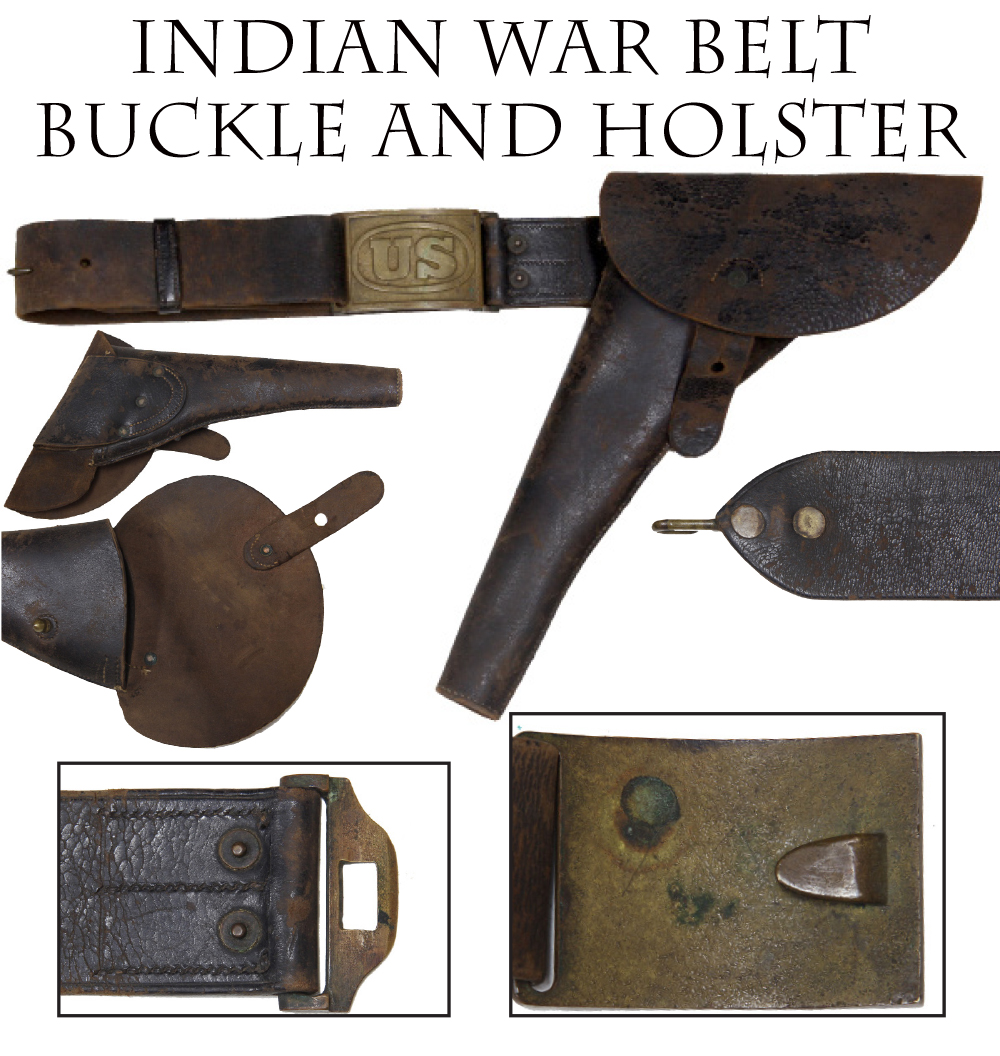
17-07-120 INDIAN WAR BELT BUCKLE with CIVIL WAR HOLSTER
US army 1872 pattern enlisted waist belt. Initially issued as part of the experimental brace system, the rectangular plate cast with a US inside an oval. Here is a very good example of that regulation Indian War belt and plate. The belt is black leather, shifting in color slightly to brown. It shows wear and use with loss of finish by abrasion, but has a pretty uniform color and no recent polish or leather treatment. Set up like a Civil War NCO belt, the hasp is fastened by stitching and rivets and the belt adjusts for size with a riveted brass wire hook. A nice Custer era belt rig. Also present is a very good condition Civil War US military issue revolver holster, which also fits the Colt Single Action Army revolver. . Full leather flap with the latch tab, belt loop and toe plug in place. Configured to carry the revolver in the standard butt-forward position on the trooper’s right side. The seam is intact and shows no gaps. The holster body has good stiffness. The flap is softer and shows more finish loss from opening and flexing. The latch tab is secured both by a semicircle of stitching and a rivet. The body was designed not fit the contour of a particular revolver too closely so that it could be used with Colts or Remingtons, both standard sidearms for Union cavalry. This had not been polished to death in recent years or greased up with leather treatment. Holsters that are complete and in decent condition are hard to find. They dress up a revolver collection and are key pieces in a cavalry collection as well. I don’t see any maker marks, but a closer inspection than I have time for might reveal one.
$675.00
sold
Call us @ 419-842-1863
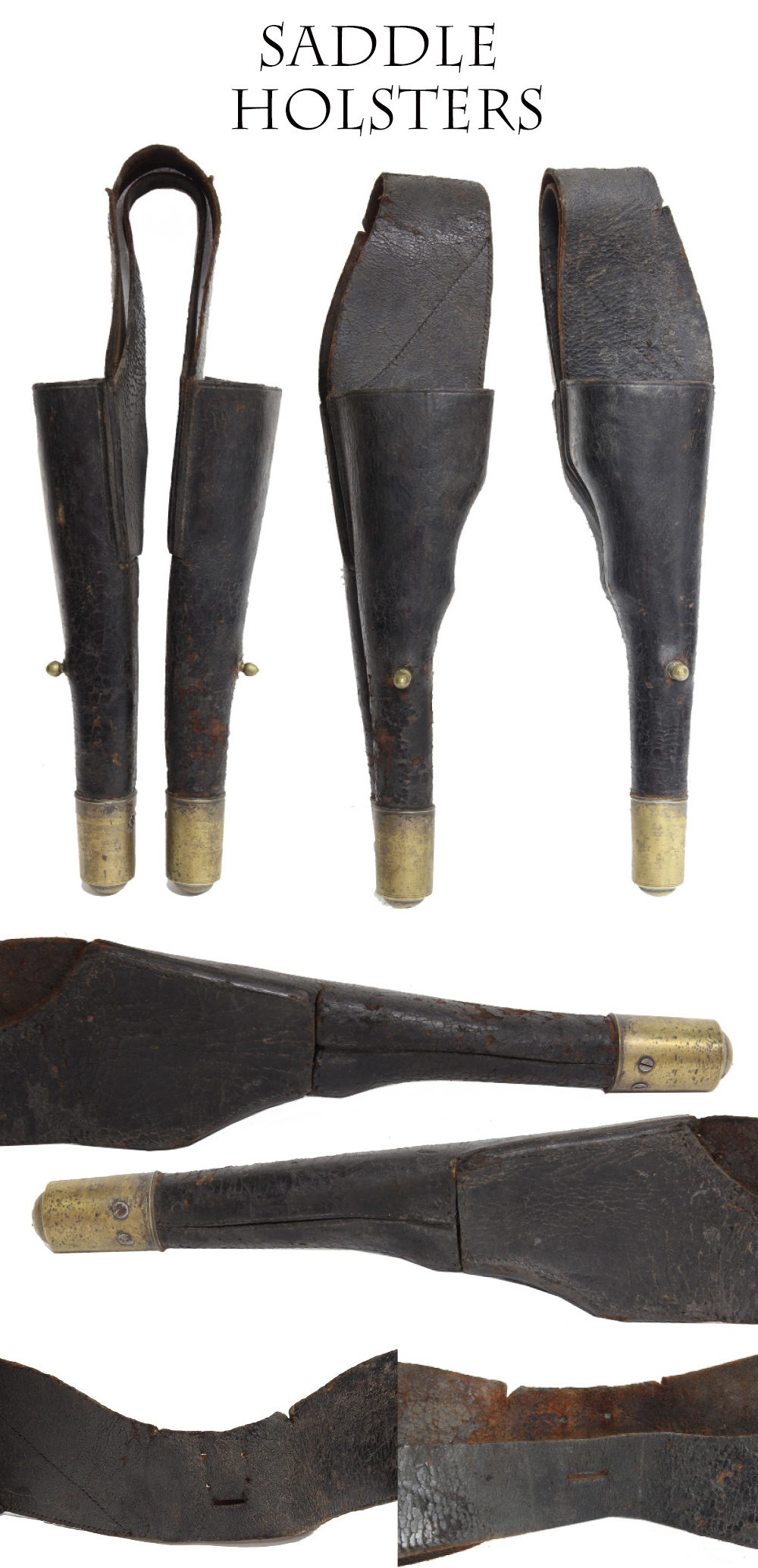
17-07-121…
SADDLE HOLSTERS….
A good pair of pommel holsters contoured for percussion revolvers that snugly fit a pair of Colt Armies. Although belt holsters were very much the standard by the Civil War, pommel holsters were often still included as part of the saddlery of field and staff officers. These have the typical heavy, black leather holster bodies with brass stud finials for cover straps and brass end caps that are secured by screws to inner wood blocks that were meant to support the muzzles of the pistols. The holster bodies are very good, solid, with good color and little finish loss. One inner seam has opened up for four inches. The upper and lower pommel straps are still pretty solid, but show some wear and finish loss from flexing, along with a couple of V-shaped edge nicks. The lower strap is slotted for a saddle stud. The upper strap has the slot and four small holes as well that enabled separate holster covers to be laced in place. This enabled them to be removed for cleaning, replaced, or simply changed to fit a buyer’s desire. These likely had separate covers that are not present.
$295.00
sold
Call us @ 419-842-1863
Layaways are Welcome
Need to split your order into multiple payments? No problem! A simple 20% earnest money deposit will hold your item for you.-acf
You can then pay it off in easy installments that fit your budget.
Read Terms Here
Items to Sell? Contact Us
I am always interested in buying ANYTHING from the American Civil War… Guns, Swords, Civil War Muskets, Knives, Uniforms, Flags, Medals, Badges, Diaries, Letters, Autographs, Buttons, photographs, tintypes, daguerreotypes, Insignia, Camp Items, Battlefield Relics, canteens, Drums, Etc… Call 419-842-1863 and ask for Dave Taylor.

